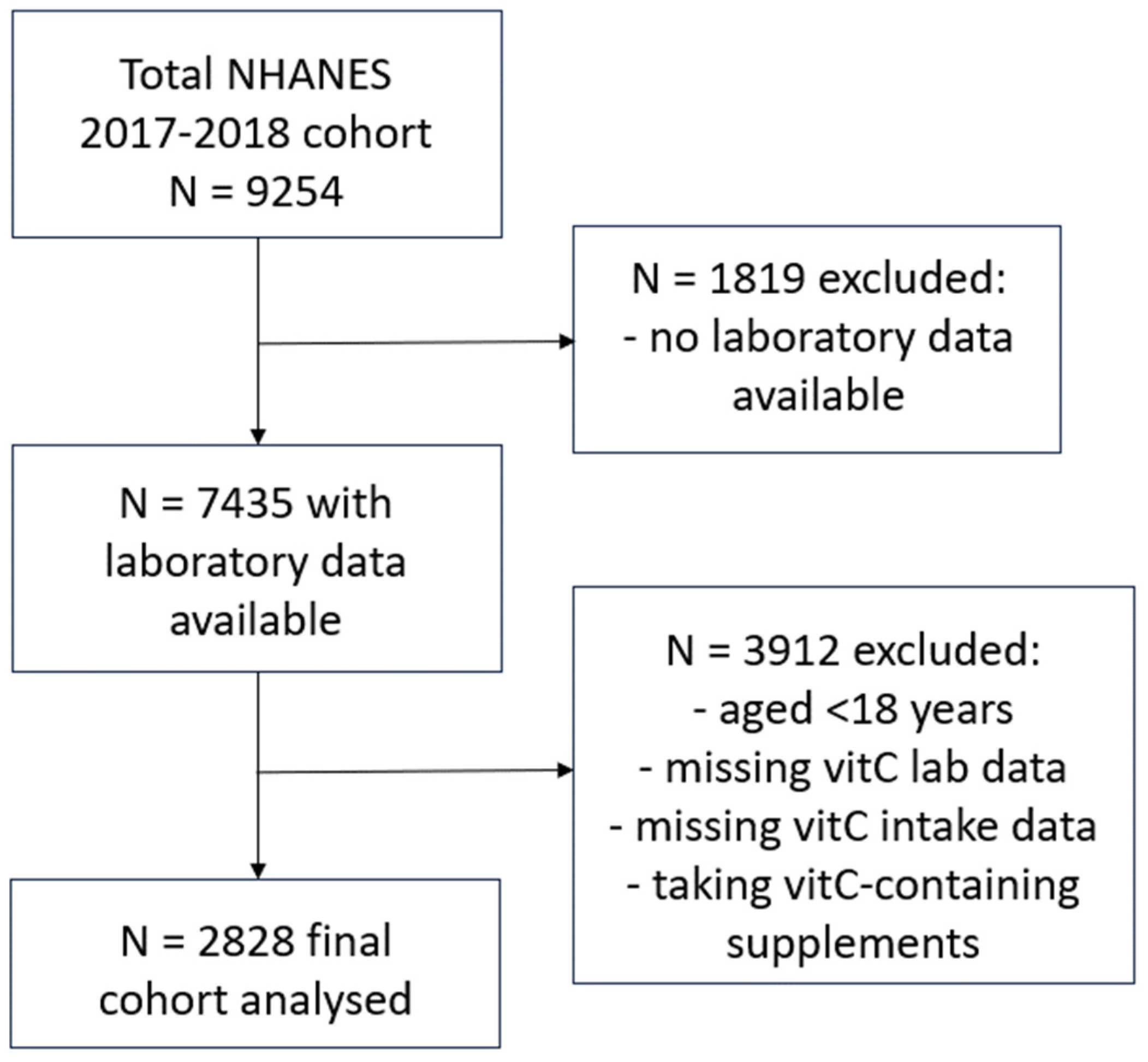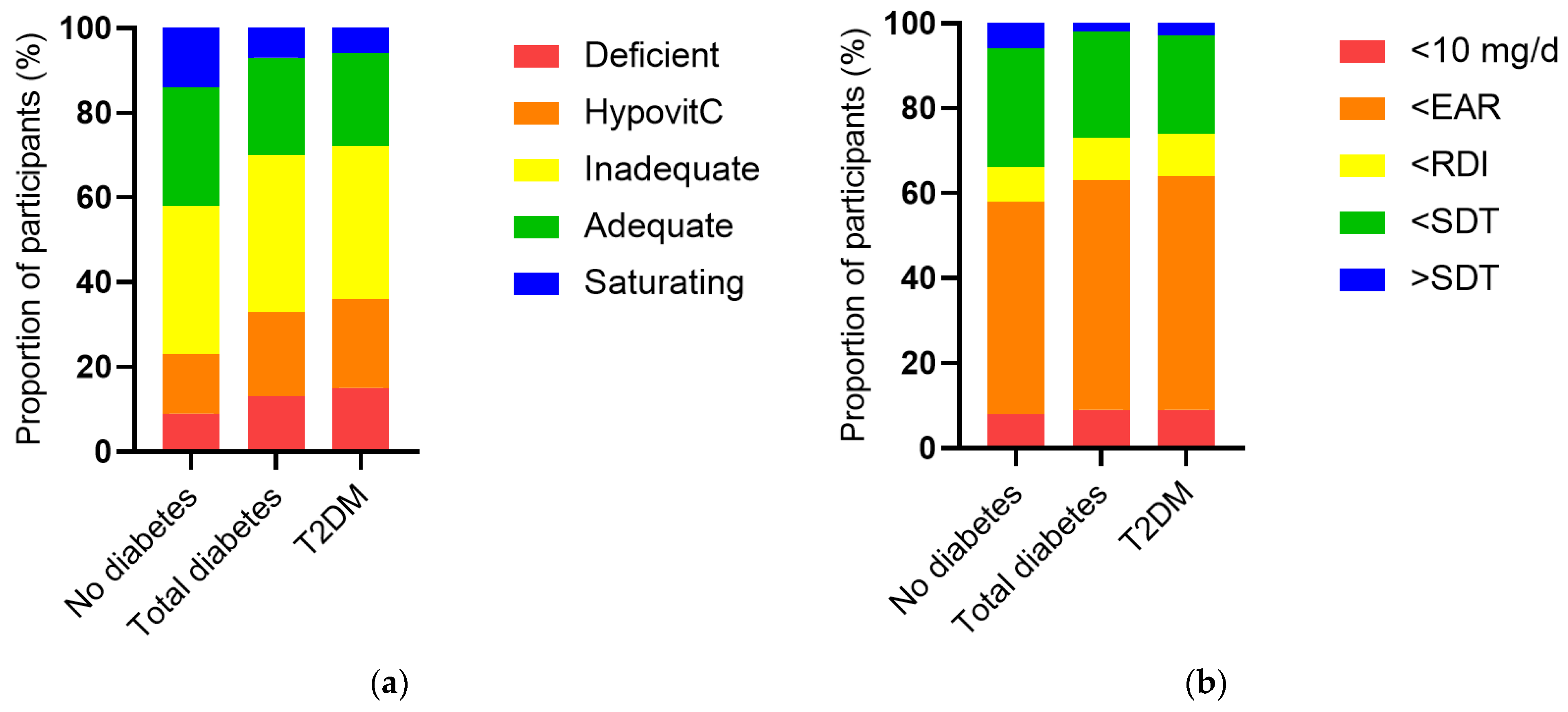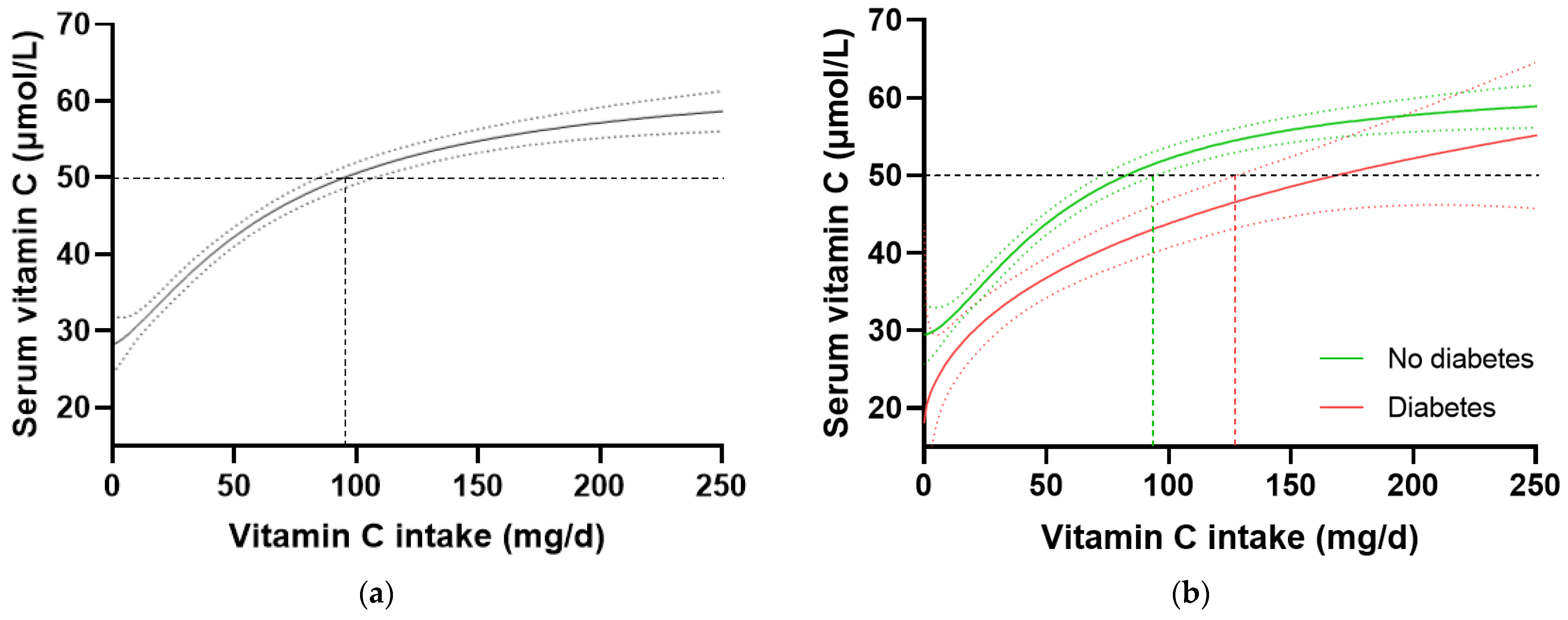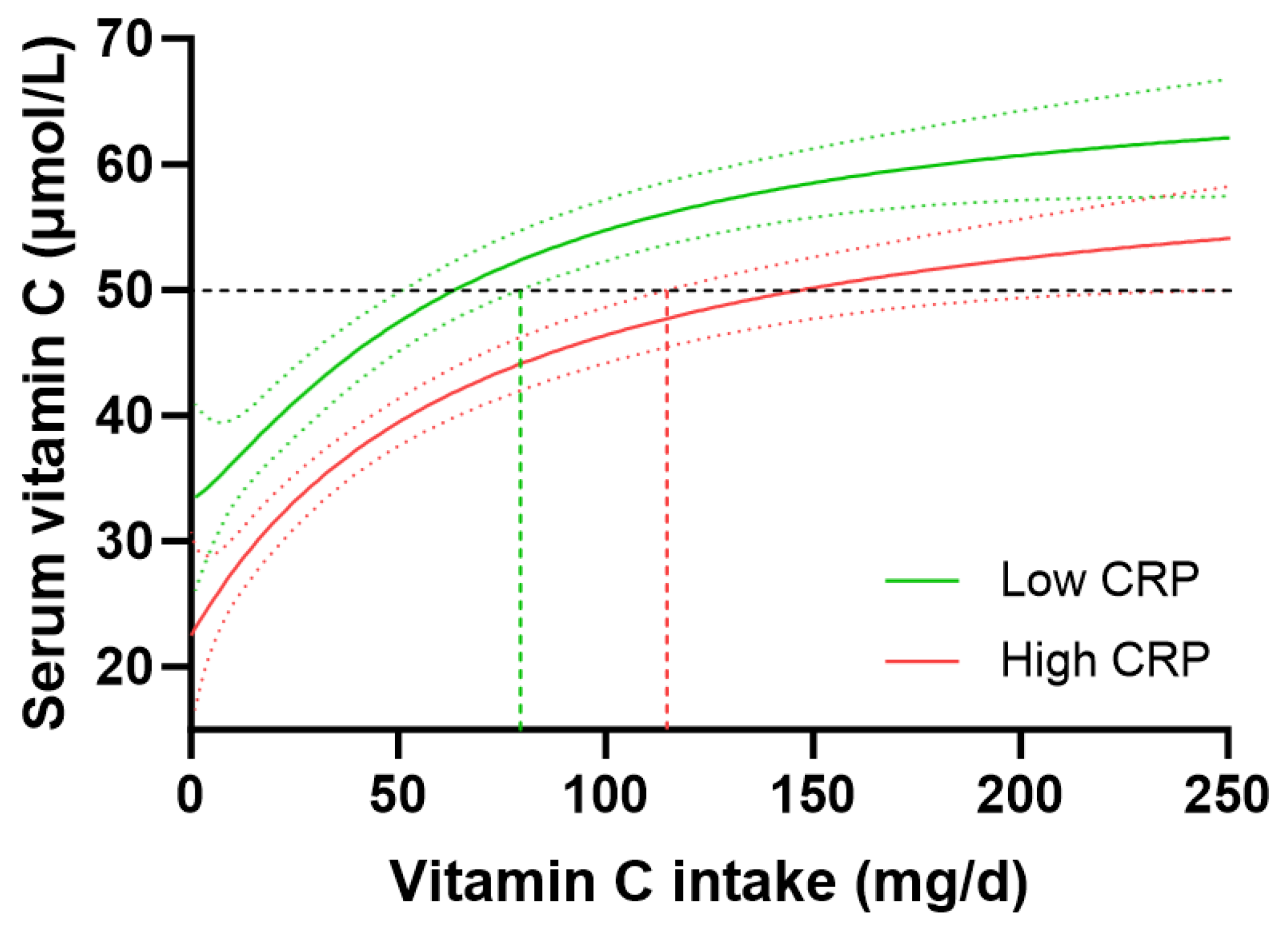Estimating Vitamin C Intake Requirements in Diabetes Mellitus: Analysis of NHANES 2017–2018 and EPIC-Norfolk Cohorts
Abstract
:1. Introduction
2. Materials and Methods
2.1. NHANES 2017–2018 Cohort
2.2. Assessment of Diabetes
2.3. EPIC-Norfolk Cohort
2.4. Data Analyses
3. Results
3.1. Characteristics of the NHANES Cohort Relative to Diabetes Status
3.2. Vitamin C Intake and Status Relative to Diabetes Status in the NHANES Cohort
3.3. Vitamin C Requirements Stratified by Diabetes in the NHANES Cohort
3.4. Vitamin C Requirements Stratified by Diabetes in the EPIC-Norfolk Cohort
3.5. CRP as a Surrogate Biomarker for the Vitamin C Dose–Concentration Relationship
4. Discussion
5. Conclusions
Author Contributions
Funding
Institutional Review Board Statement
Informed Consent Statement
Data Availability Statement
Acknowledgments
Conflicts of Interest
References
- Nishikimi, M.; Fukuyama, R.; Minoshima, S.; Shimizu, N.; Yagi, K. Cloning and chromosomal mapping of the human nonfunctional gene for L-gulono-gamma-lactone oxidase, the enzyme for L-ascorbic acid biosynthesis missing in man. J. Biol. Chem. 1994, 269, 13685–13688. [Google Scholar] [CrossRef] [PubMed]
- Englard, S.; Seifter, S. The biochemical functions of ascorbic acid. Annu. Rev. Nutr. 1986, 6, 365–406. [Google Scholar] [CrossRef]
- Young, J.I.; Zuchner, S.; Wang, G. Regulation of the epigenome by vitamin C. Annu. Rev. Nutr. 2015, 35, 545–564. [Google Scholar] [CrossRef] [PubMed]
- Kuiper, C.; Vissers, M.C. Ascorbate as a co-factor for Fe- and 2-oxoglutarate dependent dioxygenases: Physiological activity in tumor growth and progression. Front. Oncol. 2014, 4, 359. [Google Scholar] [CrossRef]
- Zheng, J.S.; Sharp, S.J.; Imamura, F.; Chowdhury, R.; Gundersen, T.E.; Steur, M.; Sluijs, I.; van der Schouw, Y.T.; Agudo, A.; Aune, D.; et al. Association of plasma biomarkers of fruit and vegetable intake with incident type 2 diabetes: EPIC-InterAct case-cohort study in eight European countries. BMJ 2020, 370, m2194. [Google Scholar] [CrossRef] [PubMed]
- Sun, H.; Karp, J.; Sun, K.M.; Weaver, C.M. Decreasing vitamin C intake, low serum vitamin C level and risk for US adults with diabetes. Nutrients 2022, 14, 3902. [Google Scholar] [CrossRef] [PubMed]
- Ou, Y.; Qiu, Z.; Geng, T.; Lu, Q.; Li, R.; Li, L.; Zhu, K.; Chen, X.; Lin, X.; Liu, S.; et al. Associations of serum vitamin C concentrations with risk of all-cause and cause-specific mortality among individuals with and without type 2 diabetes. Eur. J. Nutr. 2023, 62, 2555–2565. [Google Scholar] [CrossRef] [PubMed]
- American Diabetes Association. Diagnosis and classification of diabetes mellitus. Diabetes Care 2014, 37 (Suppl. S1), S81–S90. [Google Scholar] [CrossRef]
- International Diabetes Federation. IDF Diabetes Atlas; International Diabetes Federation: Brussels, Belgium, 2021. [Google Scholar]
- Wilson, R.; Willis, J.; Gearry, R.; Skidmore, P.; Fleming, E.; Frampton, C.; Carr, A.C. Inadequate vitamin C status in prediabetes and type 2 diabetes mellitus: Associations with glycaemic control, obesity, and smoking. Nutrients 2017, 9, 997. [Google Scholar] [CrossRef] [PubMed]
- Carr, A.C.; Spencer, E.; Heenan, H.; Lunt, H.; Vollebregt, M.; Prickett, T.C.R. Vitamin C status in people with Types 1 and 2 Diabetes Mellitus and varying degrees of renal dysfunction: Relationship to body weight. Anitoxidants 2022, 11, 245. [Google Scholar] [CrossRef]
- Olofsson, C.; Discacciati, A.; Åkesson, A.; Orsini, N.; Brismar, K.; Wolk, A. Changes in fruit, vegetable and juice consumption after the diagnosis of type 2 diabetes: A prospective study in men. Br. J. Nutr. 2017, 117, 712–719. [Google Scholar] [CrossRef] [PubMed]
- Lamb, M.J.; Griffin, S.J.; Sharp, S.J.; Cooper, A.J. Fruit and vegetable intake and cardiovascular risk factors in people with newly diagnosed type 2 diabetes. Eur. J. Clin. Nutr. 2017, 71, 115–121. [Google Scholar] [CrossRef] [PubMed]
- Sinclair, A.J.; Taylor, P.B.; Lunec, J.; Girling, A.J.; Barnett, A.H. Low plasma ascorbate levels in patients with type 2 diabetes mellitus consuming adequate dietary vitamin C. Diabet. Med. 1994, 11, 893–898. [Google Scholar] [CrossRef]
- Bondia-Pons, I.; Ryan, L.; Martinez, J.A. Oxidative stress and inflammation interactions in human obesity. J. Physiol. Biochem. 2012, 68, 701–711. [Google Scholar] [CrossRef]
- Carr, A.C.; Block, G.; Lykkesfeldt, J. Estimation of vitamin C intake requirements based on body weight: Implications for obesity. Nutrients 2022, 14, 1460. [Google Scholar] [CrossRef] [PubMed]
- Lunt, H.; Carr, A.C.; Heenan, H.F.; Vlasiuk, E.; Zawari, M.; Prickett, T.; Frampton, C. People with diabetes and hypovitaminosis C fail to conserve urinary vitamin C. J. Clin. Transl. Endocrinol. 2023, 31, 100316. [Google Scholar] [CrossRef]
- Ebenuwa, I.; Violet, P.C.; Padayatty, S.; Wang, Y.; Wang, Y.; Sun, H.; Adhikari, P.; Smith, S.; Tu, H.; Niyyati, M.; et al. Abnormal urinary loss of vitamin C in diabetes: Prevalence and clinical characteristics of a vitamin C renal leak. Am. J. Clin. Nutr. 2022, 16, 274–284. [Google Scholar] [CrossRef] [PubMed]
- Carr, A.C.; Lykkesfeldt, J. Factors affecting the vitamin C dose-concentration relationship: Implications for global vitamin C dietary recommendations. Nutrients 2023, 15, 1657. [Google Scholar] [CrossRef] [PubMed]
- Pirkle, J.L. Laboratory Procedure Manual: Vitamin C (Ascorbic Acid) NHANES 2017–2018; CDC Environmental Health: Washington, DC, USA, 2020; 26p. [Google Scholar]
- Mosslemi, M.; Park, H.L.; McLaren, C.E.; Wong, N.D. A treatment-based algorithm for identification of diabetes type in the National Health and Nutrition Examination Survey. Cardiovasc. Endocrinol. Metab. 2020, 9, 9–16. [Google Scholar] [CrossRef]
- Lentjes, M.A.; McTaggart, A.; Mulligan, A.A.; Powell, N.A.; Parry-Smith, D.; Luben, R.N.; Bhaniani, A.; Welch, A.A.; Khaw, K.T. Dietary intake measurement using 7 d diet diaries in British men and women in the European Prospective Investigation into Cancer-Norfolk study: A focus on methodological issues. Br. J. Nutr. 2014, 111, 516–526. [Google Scholar] [CrossRef]
- Welch, A.A.; McTaggart, A.; Mulligan, A.A.; Luben, R.; Walker, N.; Khaw, K.T.; Day, N.E.; Bingham, S.A. DINER (Data into Nutrients for Epidemiological Research)—A new data-entry program for nutritional analysis in the EPIC-Norfolk cohort and the 7-day diary method. Public Health Nutr. 2001, 4, 1253–1265. [Google Scholar] [CrossRef] [PubMed]
- Vuilleumier, J.P.; Keck, E. Fluorometric assay of vitamin C in biological materials using a centrifugal analyser with fluorescence attachment. J. Micronutr. Anal. 1989, 5, 25–34. [Google Scholar]
- Institute of Medicine Panel on Dietary Antioxidants and Related Compounds. Dietary Reference Intakes for Vitamin C, Vitamin E, Selenium, and Carotenoids; National Academies Press: Washington, DC, USA, 2000; p. 529. [Google Scholar]
- National Health and Medical Research Council. Nutrient Reference Values for Australia and New Zealand: Executive Summary; Department of Health and Ageing, Ed.; National Health and Medical Research Council: Canberra, Australia, 2006; p. 89. [Google Scholar]
- EFSA NDA Panel (EFSA Panel on Dietetic Products, Nutrition and Allergies). Scientific opinion on dietary reference values for vitamin C. EFSA J. 2013, 11, 3418. [Google Scholar] [CrossRef]
- Carr, A.C.; Lykkesfeldt, J. Discrepancies in global vitamin C recommendations: A review of RDA criteria and underlying health perspectives. Crit. Rev. Food Sci. Nutr. 2021, 61, 742–755. [Google Scholar] [CrossRef]
- Subramanian, V.S.; Sabui, S.; Moradi, H.; Marchant, J.S.; Said, H.M. Inhibition of intestinal ascorbic acid uptake by lipopolysaccharide is mediated via transcriptional mechanism(s). Biochim. Biophys. Acta (BBA) Biomembr. 2017, 1860, 556–565. [Google Scholar] [CrossRef] [PubMed]
- Subramanian, V.S.; Sabui, S.; Subramenium, G.A.; Marchant, J.S.; Said, H.M. Tumor Necrosis Factor alpha (TNF-alpha) reduces intestinal vitamin C uptake: A role for NF-kappaB mediated signaling. Am. J. Physiol.-Gastrointest. Liver Physiol. 2018, 315, G241–G248. [Google Scholar] [CrossRef]
- Jafarnejad, S.; Boccardi, V.; Hosseini, B.; Taghizadeh, M.; Hamedifard, Z. A meta-analysis of randomized control trials: The impact of vitamin C supplementation on serum CRP and serum hs-CRP concentrations. Curr. Pharm. Des. 2018, 24, 3520–3528. [Google Scholar] [CrossRef]
- Courderot-Masuyer, C.; Lahet, J.J.; Verges, B.; Brun, J.M.; Rochette, L. Ascorbyl free radical release in diabetic patients. Cell. Mol. Biol. 2000, 46, 1397–1401. [Google Scholar]
- Nosratabadi, S.; Ashtary-Larky, D.; Hosseini, F.; Namkhah, Z.; Mohammadi, S.; Salamat, S.; Nadery, M.; Yarmand, S.; Zamani, M.; Wong, A.; et al. The effects of vitamin C supplementation on glycemic control in patients with type 2 diabetes: A systematic review and meta-analysis. Diabetes Metab. Syndr. 2023, 17, 102824. [Google Scholar] [CrossRef] [PubMed]
- Namkhah, Z.; Ashtary-Larky, D.; Naeini, F.; Clark, C.C.T.; Asbaghi, O. Does vitamin C supplementation exert profitable effects on serum lipid profile in patients with type 2 diabetes? A systematic review and dose-response meta-analysis. Pharmacol. Res. 2021, 169, 105665. [Google Scholar] [CrossRef]
- Mason, S.A.; Keske, M.A.; Wadley, G.D. Effects of vitamin C supplementation on glycemic control and cardiovascular risk factors in people with type 2 diabetes: A GRADE-assessed systematic review and meta-analysis of randomized controlled trials. Diabetes Care 2021, 44, 618–630. [Google Scholar] [CrossRef] [PubMed]
- Tong, K.P.; Intine, R.; Wu, S. Vitamin C and the management of diabetic foot ulcers: A literature review. J. Wound Care 2022, 31, S33–S44. [Google Scholar] [CrossRef] [PubMed]
- Gunton, J.E.; Girgis, C.M.; Lau, T.; Vicaretti, M.; Begg, L.; Flood, V. Vitamin C improves healing of foot ulcers; A randomised, double-blind, placebo-controlled trial. Br. J. Nutr. 2020, 126, 1451–1458. [Google Scholar] [CrossRef] [PubMed]
- National Academies of Sciences Engineering and Medicine. Current Status and Response to the Global Obesity Pandemic: Proceedings of a Workshop; National Academies Press (US): Washington, DC, USA, 2019. [Google Scholar]






| Characteristics | Total Cohort (n = 2828) | No Diabetes (n = 2340) | Diabetes (n = 488) | p Value 1 |
|---|---|---|---|---|
| Age, years | 48 (32, 62) | 43 (29, 60) | 62 (52, 69) | <0.0001 |
| Sex, n (%) | ||||
| Male | 1425 (50) | 1171 (50) | 254 (52) | |
| Female | 1403 (50) | 1169 (50) | 234 (48) | 0.4 |
| Ethnicity | ||||
| Non-Hispanic White | 941 (33) | 801 (34) | 140 (29) | |
| Non-Hispanic Black | 727 (26) | 582 (25) | 145 (30) | |
| Mexican American | 399 (14) | 316 (13) | 83 (17) | |
| Non-Hispanic Asian | 328 (12) | 283 (12) | 45 (9) | |
| Other Hispanic | 281 (10) | 235 (10) | 46 (9) | |
| Other/multi-race | 152 (5) | 123 (5) | 29 (6) | 0.7 |
| Poverty income ratio | 1.9 (1.1, 3.8) | 2.0 (1.1, 3.8) | 1.9 (1.1, 3.7) | 0.7 |
| Current smoker 2 | 681 (25) | 588 (26) | 93 (20) | 0.006 |
| No. of years smoking | 34 (19, 47) | 30 (17, 46) | 44 (35, 52) | <0.0001 |
| No. of cigarettes/day | 8 (4, 15) | 8 (4, 15) | 10 (4, 20) | 0.2 |
| Body weight, kg | 80 (68, 97) | 79 (67, 95) | 91 (75, 105) | <0.0001 |
| Body mass index, kg/m2 | 29 (25, 34) | 28 (24, 33) | 32 (28, 37) | <0.0001 |
| Waist/hip ratio | 0.94 (0.88, 0.99) | 0.93 (0.87, 0.98) | 0.99 (0.94, 1.04) | <0.0001 |
| Systolic BP, mmHg | 123 (111, 135) | 121 (111, 133) | 130 (119, 145) | <0.0001 |
| Diastolic BP, mm Hg | 73 (65, 80) | 73 (65, 81) | 72 (65, 79) | 0.5 |
| Vitamin C intake, mg/d | 53 (24, 102) | 53 (24, 104) | 51 (26, 93) | 0.5 |
| Characteristics | Total Cohort (n = 2828) | No Diabetes (n = 2340) | Diabetes (n = 488) | p Value 1 |
|---|---|---|---|---|
| C-reactive protein, mg/L | 2.1 (0.9, 4.8) | 1.8 (0.9, 4.3) | 3.2 (1.6, 7.1) | <0.0001 |
| HbA1c, % | 5.5 (5.2, 5.9) | 5.4 (5.2, 5.7) | 7.0 (6.4, 8.2) | <0.0001 |
| FBG, mmol/L 2 | 5.7 (5.3, 6.3) | 5.6 (5.3, 6.0) | 8.3 (6.5, 10) | <0.0001 |
| Insulin, pmol/L 3 | 61 (38, 99) | 57 (37, 92) | 86 (52, 145) | <0.0001 |
| Triglycerides, mmol/L | 1.0 (0.7, 1.5) | 1.0 (0.7, 1.4) | 1.4 (1.0, 1.9) | <0.0001 |
| LDL cholesterol, mmol/L | 2.8 (2.3, 3.5) | 2.9 (2.3, 3.5) | 2.6 (1.9, 3.2) | <0.0001 |
| Total cholesterol, mmo/L | 4.7 (4.1, 5.5) | 4.7 (4.1, 5.5) | 4.7 (3.9, 5.4) | 0.004 |
| HDL cholesterol, mmol/L | 1.3 (1.1, 1.6) | 1.3 (1.1, 1.6) | 1.1 (1.0, 1.4) | <0.0001 |
| Serum creatinine, µmol/L | 74 (63, 88) | 74 (62, 88) | 78 (62, 95) | 0.005 |
| Urinary ACR, mg/g | 7.3 (4.7, 13.9) | 6.7 (4.6, 12) | 13 (6.9, 44) | <0.0001 |
| Vitamin C, µmol/L | 43 (23, 60) | 44 (25, 61) | 38 (17, 52) | <0.0001 |
| Characteristics | Spearman r | p Value |
|---|---|---|
| C-reactive protein, mg/L | −0.190 | <0.0001 |
| HbA1c, % | −0.093 | <0.0001 |
| FBG 1, mmol/L | −0.106 | <0.0001 |
| Insulin, pmol/L | −0.114 | <0.0001 |
| Triglycerides, mmol/L | −0.102 | 0.0002 |
| LDL cholesterol, mmol/L | −0.044 | 0.11 |
| Total cholesterol, mmo/L | −0.029 | 0.12 |
| HDL cholesterol, mmol/L | 0.168 | <0.0001 |
| Serum creatinine, µmol/L | −0.188 | <0.0001 |
| Urinary ACR 2, mg/g | −0.077 | <0.0001 |
| Datasets (n) | Curve 1 Intake (mg/d) 1 | Curve 2 Intake (mg/d) 1 | Δ Intake (mg/d) | Δ 95% CI (mg/d) |
|---|---|---|---|---|
| NHANES total (n = 2828) | 97 (85, 106) | |||
| No diabetes (n = 2340) | 81 (72, 93) | |||
| Diabetes (n = 488) | 166 (126, NA) | 85 | 33 | |
| Non-smokers (n = 2068) | 76 (67, 85) | |||
| No diabetes (n = 1960) | 64 (57, 74) | |||
| Diabetes (n = 378) | 145 (102, NA) | 81 | 28 | |
| EPIC total (20,692) | 65 (64, 66) | |||
| No diabetes (n = 20,193) | 64 (63, 65) | |||
| Diabetes (n = 475) | 129 (104, NA) | 65 | 39 | |
| Non-smokers (n = 18,185) | 62 (61, 63) | |||
| No diabetes (n = 17,734) | 61 (60, 62) | |||
| Diabetes (n = 439) | 126 (104, 164) | 65 | 42 |
Disclaimer/Publisher’s Note: The statements, opinions and data contained in all publications are solely those of the individual author(s) and contributor(s) and not of MDPI and/or the editor(s). MDPI and/or the editor(s) disclaim responsibility for any injury to people or property resulting from any ideas, methods, instructions or products referred to in the content. |
© 2023 by the authors. Licensee MDPI, Basel, Switzerland. This article is an open access article distributed under the terms and conditions of the Creative Commons Attribution (CC BY) license (https://creativecommons.org/licenses/by/4.0/).
Share and Cite
Carr, A.C.; Lunt, H.; Wareham, N.J.; Myint, P.K. Estimating Vitamin C Intake Requirements in Diabetes Mellitus: Analysis of NHANES 2017–2018 and EPIC-Norfolk Cohorts. Antioxidants 2023, 12, 1863. https://doi.org/10.3390/antiox12101863
Carr AC, Lunt H, Wareham NJ, Myint PK. Estimating Vitamin C Intake Requirements in Diabetes Mellitus: Analysis of NHANES 2017–2018 and EPIC-Norfolk Cohorts. Antioxidants. 2023; 12(10):1863. https://doi.org/10.3390/antiox12101863
Chicago/Turabian StyleCarr, Anitra C., Helen Lunt, Nicholas J. Wareham, and Phyo K. Myint. 2023. "Estimating Vitamin C Intake Requirements in Diabetes Mellitus: Analysis of NHANES 2017–2018 and EPIC-Norfolk Cohorts" Antioxidants 12, no. 10: 1863. https://doi.org/10.3390/antiox12101863
APA StyleCarr, A. C., Lunt, H., Wareham, N. J., & Myint, P. K. (2023). Estimating Vitamin C Intake Requirements in Diabetes Mellitus: Analysis of NHANES 2017–2018 and EPIC-Norfolk Cohorts. Antioxidants, 12(10), 1863. https://doi.org/10.3390/antiox12101863








